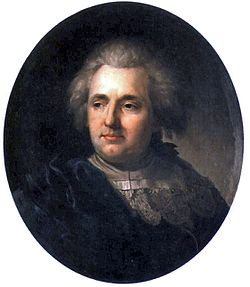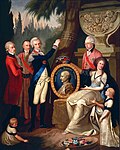| Revision as of 17:13, 12 October 2009 edit124.190.113.128 (talk)No edit summaryTag: references removed← Previous edit | Latest revision as of 03:17, 8 November 2024 edit undoMonkbot (talk | contribs)Bots3,695,952 editsm Task 20: replace {lang-??} templates with {langx|??} ‹See Tfd› (Replaced 1);Tag: AWB | ||
| (74 intermediate revisions by 45 users not shown) | |||
| Line 1: | Line 1: | ||
| {{Use dmy dates|date=June 2022}} | |||
| ⚫ | ], his student.]] | ||
| {{Short description|Polish-Lithuanian draughtsman and painter}} | |||
| ⚫ | ], his student.]] | ||
| '''Franciszek Smuglewicz''' ({{ |
'''Franciszek Smuglewicz''' ({{langx|lt|Pranciškus Smuglevičius}};<ref name=LITH>{{cite book | last = McLachlan | first = Gordon | title = Lithuania | publisher = Bradt Travel Guides | year = 2008 | pages = 40 | isbn = 978-1-84162-228-6 }}</ref><ref name=BALTIC>{{cite book | last = Rosenfeld | first = Alla |author2=Norton T. Dodge | title = Art of the Baltics | publisher = Rutgers University Press | year = 2001 | pages = 290 | isbn = 0-8135-3042-3 }}</ref> 6 October 1745 – 18 September 1807) was a ] draughtsman and painter. Smuglewicz is considered a progenitor of ] in the modern era.<ref name=LITH/> He was precursor of ] in Polish painting. He was also a founder of Vilnius school of art, his most prominent students were ], ], ] and ].<ref name="PSB">{{cite encyclopedia |last=Ryszkiewicz |first=Andrzej |author-link=Andrzej Ryszkiewicz |encyclopedia=Polski Słownik Biograficzny |title=Franciszek Smuglewicz |url=https://www.ipsb.nina.gov.pl/a/biografia/franciszek-smuglewicz |language=pl |year=1999–2000 |publisher=Polska Akademia Nauk |volume=39 |location=Warszawa-Kraków |pages=374–378 |access-date=22 November 2019 |archive-date=28 October 2020 |archive-url=https://web.archive.org/web/20201028112807/https://www.ipsb.nina.gov.pl/a/biografia/franciszek-smuglewicz |url-status=dead }}</ref> His father ] and brother ] were also painters. | ||
| ==Biography== | ==Biography== | ||
| Franciszek Smuglewicz was born in ] as son of ], who was also a painter,<ref name=Rastawiecki/> and Regina Olesińska. His mother, Regina Olesińska, was the niece of painter ].<ref>Mariusz Karpowicz. "Krakowskie obrazy Szymona Czechowicza". ''Rocznik Krakowski''. Vol. 56 (1990). p. 131</ref><ref name=Rastawiecki>]. ''Słownik malarzów polskich, tudzież obcych w Polsce osiadłych lub czasowo w niéj przebywających''. Vol. 2. 1851. p. 171</ref> He made his first steps as a painter in his father and Czechowicz joint workshop in Warsaw. In 1763 Franciszek journeyed to Rome, where he began the study of fine arts under the tutorship of ]. He stayed in Rome for 21 years, where he embraced the ] style. | |||
| ⚫ | In 1765 he received a royal scholarship from the King of Poland ] and was admitted into the Saint Lucas Academy. As a colleague of ] he participated in cataloging artifacts from ]'s '']''. In 1784 he returned to Warsaw, where he founded his own school of fine arts, one of the predecessors of the modern ]. | ||
| Franciszek Smuglewicz was born in ] into a ]-].<ref name=LITH/> His father, ], also a painter, had moved to Warsaw from the Lithuanian province of ]. In 1763 Franciszek journeyed to Rome, where he began the study of fine arts under the tutorship of ]. He stayed in Rome for 21 years, where he embraced the ] style. | |||
| ⚫ | A ], but under strong influence of the ],{{citation needed|date=April 2009}} Smuglewicz became a notable representative of historical paintings, a genre that dominated the fine arts of Poland throughout the 19th century. Around 1790 he started working on a series of sketches and ] inspired by ]'s ''History of the Polish Nation''. Although never finished, this series gained him much popularity. | ||
| ⚫ | In 1765 he received a royal scholarship from the King of Poland |
||
| In 1797 he moved to ], where he became the founder and the first deacon of the Institute of Sketch and Painting at the ]. | |||
| ⚫ | A ], but under strong influence of the ],{{ |
||
| In 1801 he painted allegorical ceiling paintings for ] at his new imperial palace, the ], in ], which was also designed by Brenna.<ref>], ''The Most Remarkable Year in the Life of Augustus von Kotzebue'', London,(1802). Vol III, pp. 60, 68 and 80.</ref> | |||
| ⚫ | |||
| ⚫ | A tutor of generations of Polish-Lithuanian painters, Smuglewicz devoted himself to historical paintings in the latter years of his life. He brought to Lithuania classical ideas and views of enlightened classicism. He painted everyday life, and the architecture of Vilnius in a realistic manner. His works helped with the ongoing reconstruction of the ] in Vilnius. | ||
| ⚫ | Among the notable surviving works of that period are ''A Meeting of the ]'' (1793) and '']'s Oath at Kraków's Old Town Market'' (1797), ''Lithuanian Peasants'', ''Freeing Peasants from Serfdom in Merkinė''.<ref name=BALTIC/> Among his works of the period are views of the city walls and city gates that were demolished during the 19th century. |
||
| ⚫ | Among the notable surviving works of that period are ''A Meeting of the ]'' (1793) and '']'s Oath at Kraków's Old Town Market'' (1797), ''Lithuanian Peasants'', ''Freeing Peasants from Serfdom in Merkinė''.<ref name=BALTIC/> Among his works of the period are views of the city walls and city gates that were demolished during the 19th century. | ||
| ⚫ | He was buried in Vilnius at ] (''Polish'': Cmentarz na Rossie), |
||
| {{commonscat}} | |||
| ⚫ | He was buried in Vilnius at ] (''Polish'': Cmentarz na Rossie), although the exact location is not known. | ||
| ⚫ | ==References== | ||
| <gallery widths="175" heights="150" class="center"> | |||
| ⚫ | {{reflist}} | ||
| <gallery> | |||
| Image:Smuglewicz-Posłowie scytyjscy przed Dariuszem.jpg| ''Scythians meeting with ]'', 1785 | Image:Smuglewicz-Posłowie scytyjscy przed Dariuszem.jpg| ''Scythians meeting with ]'', 1785 | ||
| Image: |
Image:Smuglewicz Prozor Family.jpg|Portrait of the Prozor Family, 1789, National Museum in Warsaw | ||
| File:Smuglewicz Kosciuszko 2.jpg|"] taking the oath", 1797 | |||
| </gallery> | </gallery> | ||
| ⚫ | ==References== | ||
| ⚫ | {{commons category|Franciszek Smuglewicz}} | ||
| ⚫ | {{reflist}} | ||
| ==Bibliography== | |||
| {{cite encyclopedia |last=Ryszkiewicz |first=Andrzej |author-link=Andrzej Ryszkiewicz |encyclopedia=Polski Słownik Biograficzny |title=Franciszek Smuglewicz |url=https://www.ipsb.nina.gov.pl/a/biografia/franciszek-smuglewicz |language=pl |year=1999–2000 |publisher=Polska Akademia Nauk |volume=39 |location=Warszawa-Kraków |pages=374–378 |access-date=22 November 2019 |archive-date=28 October 2020 |archive-url=https://web.archive.org/web/20201028112807/https://www.ipsb.nina.gov.pl/a/biografia/franciszek-smuglewicz |url-status=dead }} | |||
| {{Authority control}} | |||
| {{DEFAULTSORT:Smuglewicz, Franciszek}} | {{DEFAULTSORT:Smuglewicz, Franciszek}} | ||
| ] | ] | ||
| ] | ] | ||
| ] | ] | ||
| ] | |||
| ] | |||
| ] | ] | ||
| ] | |||
| ] | |||
| ⚫ | |||
| ] | |||
| ] | |||
| ] | |||
| ] | |||
| ] | |||
| ] | |||
| ] | |||
| ] | |||
Latest revision as of 03:17, 8 November 2024
Polish-Lithuanian draughtsman and painter

Franciszek Smuglewicz (Lithuanian: Pranciškus Smuglevičius; 6 October 1745 – 18 September 1807) was a Polish-Lithuanian draughtsman and painter. Smuglewicz is considered a progenitor of Lithuanian art in the modern era. He was precursor of historicism in Polish painting. He was also a founder of Vilnius school of art, his most prominent students were Jan Rustem, Jan Krzysztof Damel, Gaspar Borowski and Józef Oleszkiewicz. His father Łukasz Smuglewicz and brother Antoni were also painters.
Biography
Franciszek Smuglewicz was born in Warsaw as son of Łukasz Smuglewicz, who was also a painter, and Regina Olesińska. His mother, Regina Olesińska, was the niece of painter Szymon Czechowicz. He made his first steps as a painter in his father and Czechowicz joint workshop in Warsaw. In 1763 Franciszek journeyed to Rome, where he began the study of fine arts under the tutorship of Anton von Maron. He stayed in Rome for 21 years, where he embraced the Neo-Classical style.
In 1765 he received a royal scholarship from the King of Poland Stanisław August Poniatowski and was admitted into the Saint Lucas Academy. As a colleague of Vincenzo Brenna he participated in cataloging artifacts from Nero's Domus Aurea. In 1784 he returned to Warsaw, where he founded his own school of fine arts, one of the predecessors of the modern Academy of Fine Arts.
A classicist, but under strong influence of the Polish baroque, Smuglewicz became a notable representative of historical paintings, a genre that dominated the fine arts of Poland throughout the 19th century. Around 1790 he started working on a series of sketches and lithographies inspired by Adam Naruszewicz's History of the Polish Nation. Although never finished, this series gained him much popularity.
In 1797 he moved to Vilnius, where he became the founder and the first deacon of the Institute of Sketch and Painting at the Academy of Vilnius.
In 1801 he painted allegorical ceiling paintings for Tsar Paul I at his new imperial palace, the Mikhailovsky Castle, in St Petersburg, which was also designed by Brenna.
A tutor of generations of Polish-Lithuanian painters, Smuglewicz devoted himself to historical paintings in the latter years of his life. He brought to Lithuania classical ideas and views of enlightened classicism. He painted everyday life, and the architecture of Vilnius in a realistic manner. His works helped with the ongoing reconstruction of the Royal Palace of Lithuania in Vilnius.
Among the notable surviving works of that period are A Meeting of the Four Years' Sejm (1793) and Kościuszko's Oath at Kraków's Old Town Market (1797), Lithuanian Peasants, Freeing Peasants from Serfdom in Merkinė. Among his works of the period are views of the city walls and city gates that were demolished during the 19th century.
He was buried in Vilnius at Rasos Cemetery (Polish: Cmentarz na Rossie), although the exact location is not known.
-
 Scythians meeting with Darius, 1785
Scythians meeting with Darius, 1785
-
 Portrait of the Prozor Family, 1789, National Museum in Warsaw
Portrait of the Prozor Family, 1789, National Museum in Warsaw
-
 "Tadeusz Kościuszko taking the oath", 1797
"Tadeusz Kościuszko taking the oath", 1797
References
- ^ McLachlan, Gordon (2008). Lithuania. Bradt Travel Guides. p. 40. ISBN 978-1-84162-228-6.
- ^ Rosenfeld, Alla; Norton T. Dodge (2001). Art of the Baltics. Rutgers University Press. p. 290. ISBN 0-8135-3042-3.
- Ryszkiewicz, Andrzej (1999–2000). "Franciszek Smuglewicz". Polski Słownik Biograficzny (in Polish). Vol. 39. Warszawa-Kraków: Polska Akademia Nauk. pp. 374–378. Archived from the original on 28 October 2020. Retrieved 22 November 2019.
- ^ Edward Rastawiecki. Słownik malarzów polskich, tudzież obcych w Polsce osiadłych lub czasowo w niéj przebywających. Vol. 2. 1851. p. 171
- Mariusz Karpowicz. "Krakowskie obrazy Szymona Czechowicza". Rocznik Krakowski. Vol. 56 (1990). p. 131
- August von Kotzebue, The Most Remarkable Year in the Life of Augustus von Kotzebue, London,(1802). Vol III, pp. 60, 68 and 80.
Bibliography
Ryszkiewicz, Andrzej (1999–2000). "Franciszek Smuglewicz". Polski Słownik Biograficzny (in Polish). Vol. 39. Warszawa-Kraków: Polska Akademia Nauk. pp. 374–378. Archived from the original on 28 October 2020. Retrieved 22 November 2019.
Categories:- 1745 births
- 1807 deaths
- Polish draughtsmen
- 18th-century Polish–Lithuanian painters
- 19th-century Polish painters
- Lithuanian painters
- Academic staff of Vilnius University
- 18th-century Lithuanian people
- 19th-century Lithuanian painters
- Academy of Fine Arts in Warsaw
- Artists from Warsaw
- Polish male painters
- Burials at Rasos Cemetery